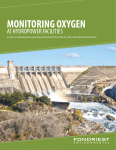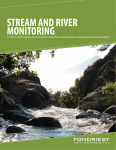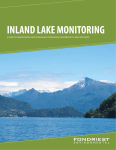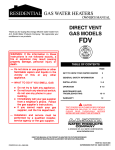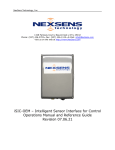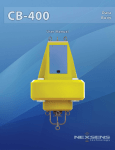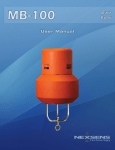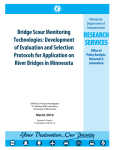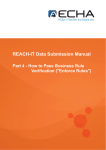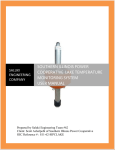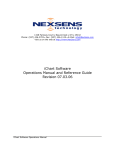Download Application Guide - NexSens Technology Inc.
Transcript
MONITORING SCOUR AT BRIDGES AND OFFSHORE STRUCTURES A GUIDE TO UNDERSTANDING AND ESTABLISHING SCOUR AS A REAL-TIME MONITORING SOLUTION WHAT’S INSIDE 01 Bridge Scour: Overview of FHWA Guidance and HEC Manuals 02 Sediment: The Foundation of Scour 04 A Real-Time Solution 06 Typical Scour Monitoring System 08 Points of Compliance 10 Data Management 12 Quality Assurance 14 Recommended Equipment 16 Purchase or Rent? 17 About Fondriest Environmental 18 System Configuration Tool WHY MONITORING MATTERS Streambed scour is the erosion of sediment at the base of bridge piers, abutments and other underwater structures. Scouring can occur in any area of water flow, from streams and rivers to tidal estuaries. This erosion is caused by water flow, and increases during times of high flow, such as during a flood. As flow speeds increase, so does the potential for sediment transport. The holes left behind in the riverbed by scour can compromise structural integrity. Bridge scour monitoring, and scour monitoring at other offshore structures can identify and prevent disasters before they strike. As scour alters the elevation of the riverbed at a pier, a monitoring system can indicate when a bridge becomes structurally deficient and dangerous due to sediment erosion. While monitoring does not make a structure less susceptible to scour, a real-time alert can be sent out if a bridge becomes scour critical and must be closed. The Federal Highway Administration (FHWA) requires every state to identify, monitor and improve any highway bridge where scour is or could become critical. As scour affects more than just highway bridges, it is recommended to monitor other bridges and offshore structures as well. These monitoring systems can be used to detect the need for immediate mitigation measures or simply to establish a schedule for structural countermeasures. Read the complete FHWA’s Stream Stability at Highway Structures (HEC 20) http://www.fhwa.dot.gov/engineering/hydraulics/pubs/hif12004.pdf Read the complete FHWA’s Evaluating Scour at Bridges (HEC 18) http://www.fhwa.dot.gov/engineering/hydraulics/pubs/hif12003.pdf Read the complete FHWA’s Bridge Scour and Stream Instability Countermeasures: Experience, Selection, and Design Guidance (HEC 23) http://www.fhwa.dot.gov/engineering/hydraulics/pubs/09111/09111.pdf BRIDGE SCOUR Overview of FHWA Guidance Flood-related scour is responsible for the vast majority of bridge failures and closings across the country. While most bridges can withstand typical water flows, 50-year, 100-year and 500-year floods can cause scour-critical status or bridge collapse. A scour-critical status is based on current instability or the potential of instability due to scour. To determine the extent of at-risk structures, the Federal Highway Administration (FHWA) established the National Bridge Inventory (NBI) and requires states to report on the conditions of public bridges. Through the NBI, structurally deficient or scour-critical bridges must be identified and a plan of action (POA) for monitoring and scour countermeasures must be developed. Monitoring plans are further outlined and discussed in the FHWA’s three-set guidance manuals. These manuals are published in the Hydraulic Engineering Circular (HEC) and are intended to be referenced in sequence. The first manual, Stream Stability at Highway Structures (HEC-20), assists in initial data collection to assess water channel classification and channel instability. The second manual, Evaluating Scour at Bridges (HEC-18), establishes procedures for hydrologic and hydraulic analysis of waterways. This manual further evaluates the existing risk and potential scour at the structure. The final guidance manual, FHWA’s Bridge Scour and Stream Instability Countermeasures (HEC-23), provides options for monitoring and combating bridge scour. HEC-23 details the need for a monitoring strategy, preferably in real-time, within the countermeasure proposal. In compliance with the NBI and often in conjunction with the U.S. Geological Survey, state DOTs can establish a thorough POA for scour-critical bridges within their boundaries. The POA is developed for each bridge individually, detailing the best countermeasure methods to monitor and remedy current bridge scour, as well as to prevent or slow its future expansion. When implementing a POA, a real-time monitoring solution is recommended. Scour monitoring is particularly important during and after flood events when immediate data can ensure timely control measures. A realtime system constantly monitors potential problem areas, and can alert bridge owners before scour becomes dangerous. Several National Cooperative Highway Research Program (NCHRP) reports substantially expound on the strength of scour monitoring as an effective countermeasure. Three of these reports (NCHRP Report 396, 397a, 397b) delve into the available scour monitoring instruments and their usefulness based on stream conditions, bridge structure and other feasibility factors. However, scour monitoring, even in real-time, does not erase scour-critical status. It is intended as a tool for early scour detection, improved response time and determining which action should be undertaken to counter scour. THE FOUNDATION OF SCOUR Sediment is the collection of organic and inorganic particles that can be moved by water and wind. In water quality terms, sediment typically refers to mineral-based matter such as clay, silt, sand and gravel that are carried into the water from the local environment. The amount of sediment and distance that these particles travel is known as the sediment transport rate. Sediment transport, and consequently erosion and deposition, are dependent on water flow. When water flow increases (whether by volume or velocity), the forces acting on a riverbed also increase. During high-flow events, such as floods and snow melt, the amount of sediment picked up by the higher flow rate increases, increasing the sediment transport rate and causing erosion. While sediment transport and deposition are an important part of most aquatic ecosystems, the constant erosion can pose a risk to man-made structures. Scour (riverbed erosion at a structure) is a consequence of excessive sediment transport. When sediment erosion occurs at the base of a bridge pier or other structure, it can cause safety concerns due to structural compromises. What is Sediment Transport? Water Flow Sediment transport is the movement of organic and inorganic particles by water. In general, as flow speeds increase, so does the potential for sediment transport. Water flow can be strong enough to suspend particles in the water column as they move downstream, or simply push them along the bottom of a waterway. Transported sediment may include mineral matter, chemicals and pollutants, and organic material. While much of the sediment load will come from runoff and bank erosion, loose sediment on the bottom of a streambed can easily be picked up and carried downstream. Due to the turbulent eddies that exist at an underwater structure, this streambed erosion is more likely to occur at the base of a pier or abutment. Water flow, also called water discharge, is the single most important element of sediment transport and streambed erosion. The flow of water is responsible for picking up, moving and depositing sediment in a waterway. Without flow, sediment might remain suspended or settle out – but it will not move downstream. Flow is required to initiate the transport. Sediment transport is not constant. In fact, it is constantly subject to change. In addition to the changes in sediment load due to geology, geomorphology and organic elements, sediment transport can be altered by other external factors. The alteration to sediment transport can come from changes in water flow, water level, weather events and human influence. The equations describing the relationship of water flow and sediment transport are both numerous and elaborate. The complexity of sediment transport rates are due to a large number of unknowns (e.g. bed geometry, particle size, shape and concentration), as well as multiple forces acting upon the sediment (e.g. relative inertia, turbulent eddies, velocity fluctuations in speed and direction). Shear stresses in the boundary layer of a sediment bed explain how much force is required for water flow to overcome relative inertia and begin sediment transport (through bedload or suspended load). When the force of water flow is high enough, scour will occur. Due to the nature of water flow around a structure, greater forces are present through horseshoe and wake vortices. These vortices accelerate sediment erosion at the base of the structure. Rain, Flooding and Water Level While sediment transport (and thus scour) relies on water flow to move a load downstream, this flow rate is variable. Water flow is affected not only by the local terrain (e.g. sediment material and slope), but by the amount of precipitation received. Rainfall influences water flow by increasing the water level (and thus volume). Precipitation causes water levels to initially rise, and then return to previous levels (base flow) over the course of hours or days. The extent to which a rainstorm will influence sediment transport is dependent on the amount and size of sediment available. While most periods of precipitation will not have a noticeable effect, excessive rain and flooding will. Flooding can cause increased sediment transport as the increased flow rate erode additional sediment from both the streambed and embankments. In fact, most of a waterway’s sediment load occurs during flood events. Scour When sediment transport removes material from a streambed or bank, the erosion process is called scour. Scour can occur anywhere that there is water flow and erodible material. Local scour is the engineering term for the isolated removal of sediment at one location, such as the base of underwater structures, including bridge piers and abutments. This localized erosion can cause structural failure, as bridges and overwater constructions rely on the bed sediment for support. While scour can occur anywhere, it is more likely to occur in alluvial waterways (erodible bed and banks), as opposed to a bedrock-based (nonalluvial) channel. As water flow is responsible for conducting sediment transport, scour can occur even during low-flow conditions. However, critical bridge scour conditions typically occur during periods of high flow, such as during a flood event. The higher flow rate can pick up more sediment, and turbulence often occurs at the base of a pier as it interrupts and accelerates the flow. This turbulence in turn will increase the forces acting on a streambed, suspending additional particles and initiating greater sediment transport. If too much sediment is removed, the structure can collapse. Scour due to flood-initiated sediment transport is the most common cause of bridge failure in the United States. While some of this sediment load comes from runoff, it is also due to the elevated water level and flow rate. Elevated water level creates additional volume in a channel, and increases the hydraulic radius (cross-sectional area of a waterway). The increased hydraulic radius drives up the flow rate, regardless of whether or not flow is uniform or non-uniform. Increased flow will add stress on the bed, making it more likely for water flow to initiate sediment transport. The higher velocity also increases erosion rates as flow overcomes the shear stress of sediment. This is why most sediment loss occurs during flood events. 2 MONI TO RING SCOUR F ON DR IE ST.COM 3 A REAL-TIME SOLUTION One of the most efficient and cost-effective countermeasures for scour is real-time monitoring. While monitoring does not prevent or eradicate bridge scour, it can provide adequate warning of scourcritical conditions. Scour monitoring instruments will measure sediment level or bed elevation near a pier or other structure. As sediment is eroded away by water flow, the elevation decreases and the instrument will measure the sediment level change. If a critical level is reached, a signal can be transmitted to the necessary personnel for bridge closure. Real-Time Scour Monitoring While portable scour monitoring instruments exist, fixed instruments can provide more frequent data in real time. It is worth noting that no single scour monitoring method can be universally applied to every site regardless of environmental conditions. However, the three scour monitoring instruments listed here (sonar, magnetic sliding collar, float-out device) were tested by the NCHRP research team and are in common use. While other instruments, such as tilt sensors, sounding rods and piezoelectric sensors can also be used for monitoring, they are not as well known or preferred. Tilt sensors measure bridge movement, not sediment erosion, which requires partial structure failure before action is taken. Sounding rods and piezoelectric sensors can provide false or inaccurate measurements. Sonar, magnetic sliding collars and float-out devices, on the other hand, all measure streambed erosion in areas of potential scour. There are three major real-time scour monitoring methods in common use. These instruments include sonar (acoustic transducer), magnetic sliding collars and float-out devices. Any of these devices can be implemented in conjunction with a data logger and real-time telemetry system. These instruments all measure elevation changes in the streambed. When excessive sediment transport occurs (such as during a flood event), the instruments will indicate the elevation change (amount of sediment removed) and can send that information to a data logger. Of all the scour monitoring methods available, sonar is the most widely used due to the ease of installation and the wider range of applicable site conditions. In addition, sonar instruments provide continuous bed level data, while magnetic sliding collars and float-out devices only indicate when scour has reached a certain depth. Sonar Sonar instruments, also known as acoustic transducers, use sound waves to “ping” the bottom of a waterway. The corresponding echo will indicate depth to the riverbed. When the transducer is angled toward an area of potential scour, the sensor will measure the level of erosion occurring. Most sonar instruments are mounted directly to a pier or substructure of a bridge. This indirect measurement method limits interference from debris in the water and makes the instruments easier to maintain. Sonar is a popular scour monitoring solution as it can continuously measure and return data. They are also easily connected to a telemetry station for real-time data transmission. These systems are also easy to implement, as they do not need to be installed or buried in the riverbed at all. However, depending on the location and environmental conditions, some above surface debris (e.g. ice flows) can interfere with the sonar. As with any monitoring solution, regular maintenance is recommended. These instruments can be equipped with one sonar transducer to monitor a specific area, or multiple devices to measure elevation changes in a wider range around the pier. If a stream migrates, shifting the potential scour area, 4 MONI TORIN G SCOUR it is fairly simple to move the system to the new at-risk pier. In addition to their appeal as continuously monitoring systems, sonar-based scour monitoring systems are recommended in deep channels, waterways with loose sediment beds and biologically active areas, as they are not as susceptible to biofouling, in-water debris or shifting sediment. Magnetic Sliding Collar the instrument becomes uncovered. However, several devices can be buried at multiple depths below the bed to signal scour progress. It is recommended to have a level of redundancy when using float-outs, as once the instrument is buried, its functionality cannot be verified. These instruments only produce a signal once uncovered, and their status cannot be checked in the interim. Any instrument failure may result in unsafe conditions, as there will be no warning of critical scour levels. Sliding collar solutions are comprised of a rod and a ring driven into the riverbed. As the sediment erodes, lowering the bed elevation, the collar slides down the rod. Magnetic triggers in the rod will determine the collar’s depth based on its position on the rod. While magnetic sliding collars can be automated or manually read, they only measure maximum scour depth. Manual magnetic sliding collar installations are fairly inexpensive, and can be easy to install during low-flow events. However, they are very susceptible to debris in the water. Automatic magnetic sliding collar systems are more expensive, but also more robust than their manual counterparts. However, in biologically active environments, such as estuaries and tidal rivers, barnacle growth and other biofouling can occur. This can interfere with scour readings, as the biofouling can prevent the ring from moving down the rod. Sonar Both versions of the sliding collar method should be firmly driven into the streambed. Installations are easier in shallow rivers and during low-flow events. In addition to debris and biofouling, sliding collars are susceptible to subsoil shifts. Any lateral movement of a waterway can make the deployment ineffective. Float-Out Device magnetic sliding collar Float-out devices are buried at varying depths in a potential scour area. When scour occurs, removing the sediment covering the device, the instrument will float to the surface. A wireless signal is transmitted to a nearby data logger to indicate its release. These instruments have an extended lifespan (5-10 years for battery operated float-outs) to maintain operability for several seasons if they are not triggered in the first year. As they are buried beneath the bed, they are not susceptible to damage from debris at all. They are also very easy to install in dry beds (intermittent streams) and riprap, though they can also be installed in wet channels with a trained diver. While relatively inexpensive and maintenance-free, these devices do have several drawbacks. One such drawback of the float-out device is that it will only provide data once the scour has progressed beyond a certain depth and float-out device F ON DR IE ST.COM 5 TYPICAL SCOUR MONITORING SYSTEM Bridge: Piers and Abutments Integrated Data Logging System While scour can occur at any underwater structure, highway bridges are most likely to be deemed scour critical and require monitoring. Scour can be found at both piers and abutments of a bridge. If too much sediment is washed away, the bridge may collapse. An integrated data logging system is a real-time monitoring station that houses the data logger, telemetry module and power/charging supply. Since it is generally cost-prohibitive to run AC power to the monitoring location, integrated solar panels are used to continuously charge the 12VDC battery for autonomous operation. Scour monitoring is a cost-effective and recommended component of any bridge scour countermeasure strategy. A monitoring strategy can be used to detect potential scour problem areas and continually survey current scour progress. This is usually done with a monitoring station mounted to the bridge structure, with one or multiple sonar sensors providing data. Mounting Hardware Data loggers can be mounted directly to the pier/abutment or to a pole on the bridge, depending on the location and recommended monitoring plan. The sonar sensor(s) should be mounted to a bracket on the pier or abutment, while water level or flow sensor(s) should be deployed in a fixed pipe. To be effective, bridge scour should be continuously monitored with the data made available in real time. The easiest and most efficient way to do this is with an integrated telemetry system. A data logger can support multiple sonar and water level sensors and log scour data from each at pre-defined intervals. With telemetry, whether radio, cellular or satellite, the system can then securely transmit the scour data to the Internet in real time for viewing from any computer. Integrated data logging and telemetry stations are customizable based on bridge scour monitoring needs. The integrated system, whether mounted on a bridge, pier or along the riverbank, can connect to and support multiple sensors, even when they are mounted on different piers. All equipment is powered via a central battery and recharging solar panel system. With multiple telemetry options to choose from, continuous real-time data is available from any computer. This ensures that the scour conditions are constantly monitored, and any control or countermeasures can be implemented immediately if the scour becomes critical. Telemetry Telemetry provides scour monitoring data in real time by sending the data to a central computer or web-based datacenter. The wireless communication can be radio-to-shore, cellular or satellite based. Sonar Depth Sensor Sonar instruments are commonly used to monitor scour as they measure the distance to the riverbed. A sonar depth sensor can frequently “ping” the river bottom to detect if sediment has shifted or washed away (changing the bed elevation). Single-beam sonar are best for monitoring one location, while multi-beam sonar can monitor a wider area. Live Data Scour data can be viewed instantly at any time 24/7 through an online datacenter. This data can be viewed in real time, or as a graph to see trends. Automated alerts can be sent in real time via text or email when scouring causes a structure to become dangerous. 6 MONI TO RING SCOUR F ON DR IE ST.COM 7 MONITORING AS A COUNTERMEASURE The number, location and even method of scour monitoring stations will vary due to local stream and bridge conditions. Before installing any monitoring systems, a channel-stability assessment should be conducted. For most bridges in the US, this can be included in the examination required by the National Bridge Inspection Standards. This assessment will help determine what (if any) scour countermeasures are necessary. The site and structure should first be examined for scour critical factors, such as existing scour, channel stability (stream and bed type, erodible banks), and other environmental characteristics. Short and long-term geomorphic changes, coupled with bridge design and local site conditions can all affect scour potential at a structure. Scour-Critical Structures Selecting the Instrumentation A structure is considered scour-critical if the abutment(s) or pier foundation(s) are coded unstable. This classification can be due to current observed scour or a high potential for scour as determined by the assessment. Scour-critical structures can include more than bridges with existing damage or migrating streams. Presently sound bridges with no observable scour, but that have a future scour risk due to calculations of 100-year flood conditions, are also classified as scour critical. Once a structure has been deemed scour critical by a bridge inspection or channel-stability assessment, the next step is to determine which countermeasures are most efficient and cost-effective for the location. Scour monitoring as a countermeasure is used to survey scour progress and identify potential scour before it becomes a hazard. Based on environmental conditions, including river type, flow rate and bed material, one instrument may be better suited than others. Whether or not the monitoring countermeasure is intended as a short or long-term solution will also play a role in instrument selection. If conditions and budget allow for it, multiple instruments may be used to cover all situations, as well as to provide data redundancy and quality assurance. The chart below can be consulted to assist in determining which instrument would be best suited to a structure based on monitoring needs and river conditions. For most sites, scour monitoring is considered an effective component of the plan of action, if not the sole countermeasure in use. Scour-critical bridges with no existing scour and a minimum risk may only need a monitoring component as the countermeasure plan of action. Older structures with unknown foundations and low-level risk may also only have a scour monitoring countermeasure in their plan of action. Though a bridge’s approved plan of action may only require scour monitoring, this does not fix or erase the problem. The bridge will remain coded as a scour-critical bridge unless other hydraulic or structural countermeasures are also implemented. ABUTMENT SCOUR PIER SCOUR FLOODPLAIN / CHANNEL SCOUR VERTICAL INSTABILITY LATERAL INSTABILITY RIVER TYPE STREAM SIZE VELOCITY POSSIBLE YES YES YES POSSIBLE ALL ALL ALL MAGNETIC SLIDING COLLAR YES YES YES YES POSSIBLE ALL ALL ALL FLOAT-OUT DEVICE YES YES YES YES YES ALL ALL ALL BED MATERIAL ICE / DEBRIS LOAD BANK SLOPE FLOODPLAIN FLOW HABIT WATER DEPTH EXTREME CONDITIONS FOUNDATION TYPE ALL LOW ALL ALL ALL ALL TEMPERATURE, ICE, VELOCITY ALL MAGNETIC SLIDING COLLAR SAND, FINE ALL ALL ALL ALL <3 - 30 FT ALL ALL FLOAT-OUT DEVICE SAND, FINE ALL ALL ALL EPHEMERAL, INTERMITTENT <3 - 30 FT ALL ALL DATA MONITORING REMOTE TECHNOLOGY MAXIMUM RANGE MAINTENANCE SONAR CONTINUOUS YES 30 FT MEDIUM MAGNETIC SLIDING COLLAR CONTINUOUS YES 5 FT MEDIUM DISCREET YES N/A LOW SONAR System Location and Deployment Typically, scour monitoring stations are mounted directly to the bridge structure or near the foundation bed. This allows them to monitor high-risk areas that are vulnerable to scour. While multiple instruments may be impractical on small, low-traffic structures, it may be cost-effective to monitor multiple piers for scour on a larger, high-traffic bridge. However, due to budget constraints, most structures will only have one monitoring station. Mounted scour monitoring systems can be set up anywhere that features a supportive foundation. Common deployment locations include pole or wall mounting directly to a bridge deck or pier. For ease of access, the data logger is often mounted on the bridge deck, while the sensors are mounted below. The system can include a locking stainless steel enclosure to protect the data logger and telemetry modem from harsh weather and vandalism. Connected sensors run from the station down the pier, into or over the water. Sonar sensors are mounted out from the pier face, while magnetic sliding collars are driven into the sediment at the base of the pier. Float-out devices are not connected at all, but are buried near the bridge foundation. These devices should still have a signal-receiving unit on the bridge deck or mounted nearby to log when the instrument becomes uncovered. SONAR FLOAT-OUT DEVICE 8 MONI TO RING SCOUR Some plans of action may require additional monitoring beyond scour and sediment erosion. Adding other hydraulic variable sensors and structure monitors provides useful data for scour research and offer a more thorough approach to scour monitoring. Extra instrumentation often includes water level sensors (stage sensors), velocity or flow sensors, temperature sensors and tiltmeters. The use of additional sensors is more common with grantfunded or USGS-partnered projects, as the supplementary data can be collected for more accurate scour predictions and modeling. These additional sensors can easily be connected to the monitoring station data logger for data transmission. F ON DR IE ST.COM 9 DATA MANAGEMENT A major part of bridge scour monitoring is the need for raw data. While it is possible to visit a site to periodically measure riverbed elevation, a realtime scour monitoring system is generally more cost-effective. The ability to frequently measure, log and download the monitoring data in real-time means more raw elevation data for more accurate sediment transportation models. Real-time alerts by text or email also ensure a faster response time when adverse conditions arise. Data Logger As the name implies, a data logger is an instrument that stores data. In environmental monitoring applications, data loggers can be used not only to collect data from sensors and monitoring instruments, but to control log intervals and transmit data to a central location in real time. While some scour monitoring instruments have the ability to log their own data, a separate, dedicated data logger can gather all data from any and all attached sensors ensuring that no data are lost. If telemetry (wireless communication) is available, the logger can remotely control measurement intervals and transmit the collected data to a central project computer. Data loggers with telemetry technology can provide real-time scour data and remote access via a cellular modem, radio transmission or satellite modem. Most scour monitoring systems use a mounted data logger on the bridge deck or other structure. The equipment is powered by an external battery (often housed in the same enclosure) with a recharging solar panel. For bridge-mounted systems near an AC power source, an AC converter can be used. Data loggers can be configured with a number of sensor ports for connection to industry-standard digital and analog interfaces, including RS-485, SDI-12 or 0-2.5 VDC. Sonar sensors and other scour monitoring instruments can connect to a logger directly or through wireless transmissions (typically float-out devices). A data logger can also handle additional hydrologic sensors (including water level or water flow) for more thorough data. Telemetry Telemetry, or wireless communication, is a useful tool for monitoring scour in real time. Common telemetry options are cellular and radio, though satellite telemetry can be used in more remote locations. The deciding factor when determining the most cost-effective telemetry option should be the local site conditions and proximity to a project computer. All three of these options permit real-time updates for local scour conditions. Radio telemetry is recommended when all equipment is in close proximity. If equipped with a license-free spread-spectrum radio, a data logger can communicate with a shore-side or dam-mounted radio base station. This range may vary depending on the logger and base station used. Spread-spectrum radio technology may allow a range as far as five miles (line-of-sight) or a few hundred feet (non-line-of-sight). The radio base station serves as a central hub for any compatible data logger in range, with the ability to send the collected data to a project computer. Cellular telemetry offers more geographic flexibility than radio, though it does require a cellular data plan. This small, additional cost permits data transmissions from anywhere that receives a cellular signal. With cellular telemetry, monitoring stations do not need to be in close proximity, nor is a 10 MONI TO RING SCOUR base station required. If multiple monitoring stations are required, each data logger can send information individually to a central database. All the data can then be accessed wirelessly from any computer via the Internet. Data loggers may be equipped with cellular modems from different providers, including AT&T, Verizon and Sprint. For remote applications where radio and cellular telemetry are not feasible, satellite telemetry can be used. The Iridium communications network maintains a dynamic, cross-linked constellation of Low Earth Orbiting (LEO) satellites, providing coverage all over the world. This means that data loggers with an Iridium satellite modem can transmit data in real time from anywhere on Earth. As with cellular networks, the data are sent to a central gateway, which then transfers the data over the Internet to any project computer or cell phone. Real-Time Online Datacenter The easiest way to share and view scour monitoring data is through a webbased datacenter. An online datacenter offers 24/7 instant access to project data via any web browser. Scour monitoring and other data (such as water level) can be exported into the datacenter directly from the data logger, or through the project software. This project management service can be password-protected or public, and allows users access to the collected data in real time. In addition to any streambed elevation information, the online interface can provide dynamic area maps, overlaid with weather information, recent and historical data, time-series graphs, and statistical summaries. Visitors can interact with the project maps and view real-time monitoring data or scour trends over time. But these cloud-based datacenters are more than just a pretty face. Many can be programmed to send out automated alarm notifications when streambed erosion becomes critical. These limits are determined by collecting background data, as per the channel stability assessment or NBIS inspection. Once a structural safety limit has been set, the data are entered into the online database. If sediment erosion reaches the established limit, the datacenter can issue an alert (text and/or email) to the bridge owner or appropriate personnel. With the availability of real-time data and the datacenter’s auto-alert system, timely control procedures can be implemented to close down the bridge or to engage in additional countermeasures when scour becomes critical. Alerts are most useful when used in conjunction with additional sensors, such as flow or water level instruments. The online datacenter can transmit the scour critical alert back to the data logger in response to the flow rate, water level or streambed elevation readings. Automated responses may include taking more frequent measurements during flood events, then resuming regular log intervals when water levels return to normal. F ON DR IE ST.COM 11 QUALITY ASSURANCE To ensure and maintain structure safety, accurate data are important. Accurate scour information can help prevent structure failure by keeping bridge owners and other personnel aware of scour critical conditions. Ideally, all equipment should meet or exceed the NCHRP’s desirable criteria for sensor quality and robustness. In addition, best practice recommends regular maintenance of sensors and equipment to prevent damage and interference from debris or shifting sediment conditions. If a budget allows it, redundancy is also recommended to confirm that all sensors are operating within specifications. System Maintenance Mandatory Monitoring System Criteria The majority of fixed scour monitoring systems require regular maintenance. Whether the main instrument in use is a sonar sensor or a magnetic sliding collar, the equipment will need to be checked for functionality and to remove debris. While most scour monitoring instruments do not require calibration, the quality of data can be affected by external influences, particularly debris. The exception is float-out devices, as they cannot be accessed while they are installed. The National Cooperative Highway Research Program (NCHRP) developed four mandatory criteria and six desirable criteria for any scour monitoring system. The required benchmarks were established as necessary for a successful monitoring application, while the desirable conditions will assist in effectiveness and efficiency. During the NCHRP’s testing, both sonar and sliding collar systems were thoroughly tested to meet all of the mandatory and desirable criteria. While the trialed float-out device also met the requirements, it was not as thoroughly tested. For sonar-based monitoring systems, the sensor face should be kept clean and the setup should be regularly checked to prevent damage due to vandalism or above-water debris. Magnetic sliding collar systems are harder to maintain as they are below the surface of the water. However, it is extremely important to inspect the equipment regularly, particularly in waters with risk of biological growth (algae or barnacles). Biofouling can interfere with readings and damage the equipment if not removed. Data loggers should also be included in the maintentence check. The enclosure dessicant pack should be replaced regularly to prevent moisture damage to the electronics, and the battery may need to be replaced every three to five years. Ideally, a scour monitoring system should be installed in such a way as to protect the sensors and instruments from damage. This can include a deployment pipe or other robust material to guard the equipment from debris. For structure-mounted systems or data loggers, a locked enclosure can help deter vandalism. For greater details regarding maintenance requirements, the manufacturer’s user manual and the HEC guidelines should be referenced. 12 MONI TO RING SCOUR Mandatory Criteria • Capability for installation on or near a bridge pier or abutment • Ability to measure maximum scour depth within an accuracy of +/- 1 ft • Ability to obtain scour depth readings from above water or from a remote site • Operable during storm and flood conditions Desirable Criteria • Capability to be installed on most existing bridges or during construction of new bridges • Capability to operate in a range of flow conditions • Capability to withstand ice and debris • Relatively low cost • Vandal-resistant • Operable and maintainable by highway maintenance personnel The NCHRP report stressed that while some methods were more applicable than others, no single instrument will be the best option for any and every site. The best scour monitoring system should be chosen based on sitespecific bridge conditions, environmental conditions and potential for other influences. F ON DR IE ST.COM 13 RECOMMENDED EQUIPMENT While there are a variety of scour monitoring instruments to choose from, some stand out above the rest. Fondriest Environmental has selected these products as the best in their field for their accuracy, dependability and value. Together, they provide an innovative and responsive real-time scour monitoring system. The Airmar EchoRange SS510 Smart Sensor is a low-cost depth sonar with digital output for scour and sediment transfer studies. The sensor features a robust stainless steel housing with 1/2″-14 NPS threads for convenient mounting. The NexSens MAST data logging system arrives fully assembled, tested and operational with integrated solar power and a choice of real-time radio, cellular, and satellite communications. Alone, real-time data are good, but with remote data collection, 24/7 access from any computer, instant alarm notifications and trend tracking, the intuitive WQData LIVE takes real-time data to the next level. Airmar EchoRange SS510 Depth Sensor NexSens MAST Wireless Telemetry System The Airmar EchoRange SS510 Smart Sensor is a digital depth sonar for bridge scour monitoring, sediment transfer studies, and much more. Pairing the compact sensor with a computer or data logger provides a low-cost, portable hydrographic survey system. The EchoRange can also be fixed to a bridge abutment or pillar for unattended monitoring of scour conditions. The sensor digitally processes depth and water temperature signals to communicate data via NMEA 0183 protocol. Using NMEA 0183, the sensor easily interfaces with computers or data collection platforms with a data output rate up to 10 times per second. The EchoRange is constructed with a robust stainless steel housing and has a measurement range from 0.4m to 200m with 0.01m resolution. The iSIC-MAST system includes the data logger and solar panel premounted to a 2” diameter pole to create a truly plug-and-play data collection and sensor interface platform. The system integrates a NexSens iSIC data logger and 20-watt solar power kit - all in a compact, pre-configured package. Simply thread the system to any 2” NPT male pipe thread, connect the solar panel & battery, wire the sensors, and setup a project using iChart software - it’s that simple! 14 MONI TO RING SCOUR NexSens WQData LIVE Web Datacenter WQData LIVE is a web-based project management service that allows users 24/7 instant access to data collected from NexSens remote environmental data logging & telemetry systems. More than just an online database, WQData LIVE offers the ability to generate automated reports, configure alarms to notify project personnel when data values exceed threshold limits, create FieldBooks to store calibration forms, notes and media and much more. Projects are password protected with the ability to configure a public portal or presentation view to share data with the general public. Project Administrators have the ability to edit project descriptions and information, while users given Collaborator access are limited to data viewing and form entry. The iSIC data logger arrives ready for long-term deployment. All electronics are housed in a rugged, NEMA 4X enclosure constructed of heavy-duty fiberglass. The built-in 8.5 amp-hour sealed lead acid battery provides 12 volt power to the system, and the battery is continuously charged using solar power. Polymer-coated circuit boards, sealed connectors, corrosionresistant stainless steel hardware and built-in lightning protection ensure reliable performance in the harshest conditions. All sensors are cabled through Sealcon gland fittings to ensure protection from the elements. The Google Maps view shows all project sites on a map with zoom, scroll and drag capability. Mousing over a site on the map displays the most recent data values, and clicking on the site navigates to a display showing the last reading or tabular data that can be downloaded to Excel and sent via email or FTP. FieldBooks can be created to store notes recorded during field visits, including forms to store calibration data, which can be submitted from the WQData LIVE mobile app. This eliminates the need for conventional fieldbooks while keeping critical project information in a single, easy-to-access location. Site photos can even be placed onto FieldBook pages or uploaded into the project’s Media page. NexSens iChart Software is a Windows-based program for interfacing to an iSIC data logger or network of data loggers. The iChart Setup Device Wizard includes built-in drivers and a step-by-step interface for setting up and configuring remote monitoring sensors and systems. When connected, the user can quickly configure sample & log intervals, upload data, or troubleshoot communications. The WQData LIVE report feature allows data to be shown both graphically and in a tabular format. Report templates can be saved so that specific information can quickly be referenced. Project alarms send email or text messages to project staff for immediate notification of critical conditions. With this unique set of features, WQData LIVE provides everything needed to effectively manage an environmental monitoring application. F ON DR IE ST.COM 15 PURCHASE OR RENT? ABOUT FONDRIEST When managing a large or long-term scour countermeasure project, purchasing several scour monitoring systems is often the most economical option. However, for short-term monitoring projects on a tight budget, it may not be practical to purchase the necessary scour monitoring equipment. In these situations, it is much more prudent to rent real-time monitoring systems. With several lease duration and extension options available, the flexibility of renting scour monitoring systems may still be cost-effective for the larger countermeasure applications as well. Company Scour monitoring equipment can be rented instrument by instrument, or as an entire system, calibrated and ready to deploy on arrival. Rental equipment can include sonar, hydrologic sensors, sondes, handheld displays, data loggers, telemetry stations, and web-based datacenter access. Realtime telemetry via radio-to-shore, cellular, and satellite can also be incorporated. A large rental pool also means that most scour monitoring equipment can be shipped same-day for quick deployment and emergency situations. We work closely with NexSens Technology, a company that specializes in the design and manufacture of real-time environmental measurement systems. A variety of sensor, platform and telemetry options are available to fit the unique needs of each project. We can provide complete integrated solutions and support projects from conception to completion. An extensive fleet of rental equipment is also available for short-term project needs. Just as with Fondriest purchases, rental projects have access to a knowledgeable support staff who will provide personalized service before, during and after the project. Located in the Lower Great Lakes and Ohio River Valley region, Fondriest Environmental is a leading distributor and integrator of equipment for natural resource professionals and outdoor enthusiasts. Our team of specialists can help customers understand the products they are buying and make the correct decisions out in the field. We seek to understand project needs, devise a comprehensive solution, provide the equipment and knowhow to implement it and then offer long-term project support for whatever needs arise. Capabilities Certifications Fondriest Environmental is a Certified Repair Center for YSI, NexSens & FishSens, offering quick turnaround, affordable labor rates and personalized service. Our knowledgeable technicians are available for phone, email and onsite support when the need arises. Publications We cover many customer projects in our Environmental Monitor magazine, which is updated daily online and printed quarterly. We also produce Lake Scientist, an interactive online resource providing research articles and news on lake ecology. Informational pages on environmental parameters and applications are available in the Measurement Sciences section of our website. And FishSens Magazine, available online, provides anglers, boaters and fisheries professionals with the latest fish science news. Commitment Fondriest Environmental, Inc. 2091 Exchange Court Fairborn, OH 45324 tel: 888.426.2151 fax: 937.426.1125 [email protected] 16 MONI TO RING SCOUR A commitment to integrity and longstanding customer relations are the standard, rather than the exception, at Fondriest Environmental. We support professionals, educators and researchers who continuously work to monitor and protect our global resources by providing them with the products and services needed to face today’s environmental challenges. Our team of solution-driven experts has years of field experience and a keen eye for finding the best equipment for each application. Contact Information To reach an application specialist, please call (888) 426.2151 or email [email protected] F ON DR IE ST.COM 17 SYSTEM CONFIGURATION TOOL Site Location Fondriest application specialists will assist with tailoring system configuration and equipment choices on a site-by-site basis to ensure reliability and proper data management. The questionnaire below can help you get started. Once completed, this form can be faxed to (937) 426.1125 or, if completed digitally, emailed to [email protected]. The location of a monitoring system can affect what equipment platform best suits the conditions. Please select in what type of water body the system will reside. Contact Information Name: Organization: Lake River Coastal Other Please Specify Number of Instruments While multiple instruments may be impractical on small, low-traffic structures, it may be cost-effective to monitor multiple piers for scour on a larger, high-traffic bridge. 1-3 3-5 5-10 Other Please Specify Telephone: Email: Site Conditions Describe the site conditions in a paragraph or two. Please include details regarding levels of wind, waves and boat traffic experienced in the area. Approximate Depth The mounting hardware and cable lengths used for a deployment depends on the distance to the sea floor. An application specialist can develop the best monitoring plan to accommodate the approximate water depth. < 5 ft. Between 5 and 25 ft. Between 25 and 50 ft. Between 50 and 100 ft. > 100 ft. Water Level Fluctuation Sonar sensors need to be mounted below minimum pool in order to effectively measure distance to bottom. <5 ft. Between 5 and 25 ft. Between 25 and 50 ft. Other Please Specify Telemetry License-free spread-spectrum radio telemetry allows communication with a shore-side NexSens radio base station as far as five miles line-of-sight from the monitoring site. Cellular telemetry allows greater geographic flexibility and is able to transmit from almost anywhere in the U.S., but it includes the cost of a cellular data plan. Satellite telemetry can be used nearly anywhere in the world, but it tends to have the highest data cost compared with cellular telemetry. Cellular Radio Satellite None Project Length (Rental vs. Purchase) Although it often makes sense to purchase systems outright, many short-term projects make it cost-prohibitive. Fondriest Environmental offers real-time scour monitoring systems with weekly and monthly rental rates to accommodate these operations. An application specialist can make recommendations on what choice is most cost-effective. 1-3 Months 18 MONI TO RING SCOUR 3-6 Months 6-12 Months >1 Year Please Specify F ON DR IE ST.COM 19 when your research demands quality data PRSRT STD US POSTAGE PAID DAYTON, OH PERMIT# 860 Fondriest Environmental, Inc. 2091 Exchange Court Fairborn, OH 45324 P 888.426.2151 F 937.426.1125 E [email protected] TAKE YOUR PROJECT TO THE NEXT LEVEL. CONTACT A FONDRIEST APPLICATION SPECIALIST 888.426.2151













